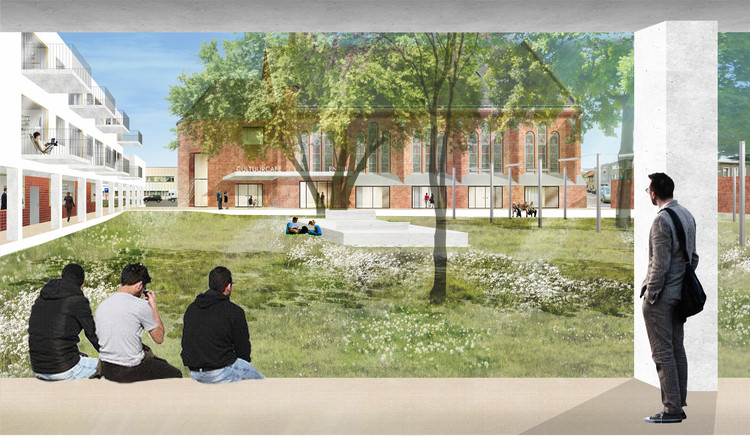.jpg?1563475598)
Past, Present, Future is an interview project by Itinerant Office, asking acclaimed architects to share their perspectives on the constantly evolving world of architecture. Each interview is split into three video segments: Past, Present, and Future, in which interviewees discuss their thoughts and experiences of architecture through each of those lenses. The first episode of the project featured 11 architects from Italy and the Netherlands and Episode II is comprised of interviews with 13 architects from Spain, Portugal, France, and Belgium.
The goal of the series is to research these successful firms and attempt to understand their methods and approaches. By hopefully gaining a clearer picture of what it means to be an architect in the 21st century, the videos can also serve as inspiration for the next generation of up-and-coming architects and students as they enter the field.
.jpg?1563476077)
Stéphane Beel is a Flemish contemporary architect and founder of the firm Stéphane Beel Architects. Graduating from his architecture studies in Ghent in 1980, Beel and his namesake firm went on to design and complete a number of stunning projects in Belgium. These include the FNG Group Headquarters office building; the UZ Gasthuisberg psychiatry building; Kanaal, a mixed use building in a former industrial site; etc.
Following are the videos and selected quotes from Stéphane Beel’s interview.
.jpg?1563464539)
.jpg?1563464620)
PAST:
Beel reminisces about the first commission he received after graduating from school and how this formative experience kickstarted his career.
Past, Present, Future - PAST. Interview with Stéphane Beel from Itinerant Office on Vimeo.
GIANPIERO VENTURINI : Can you briefly go through the most important points of the beginning of your career and the reasons you decided to study architecture and to start the profession?
STÉPHANE BEEL: After school, I didn’t want to go to a big studio, I wanted to learn for myself. It was a bit stupid also because of course you have to learn from someone. But I did learn from the books and so on, and I had to earn money so I got a commission for a small house. I asked my clients, “Can I build this house, also, by myself?” They said okay. I’m not a mason so I don’t put bricks one on top of another, I worked on this house and I could do it myself as a non-specific constructor with materials that are used in building. So at that moment, I was working on architecture with my hands. It was really architecture with a big ‘a’ for me. I was working in my working clothes, pouring water to make concrete. At the end, when it was finished, we got an important prize for it so it was the beginning of my career. I felt I had to be very exact and that I had to do it myself so I never trusted anyone else to do it. And that’s why I did it and also because of the earnings. I just thought I’d do it on my own and then commissions came.
PRESENT:

Beel discusses the organization of his office and in particular his positive interactions with coworkers.
Past, Present, Future - PRESENT. Interview with Stéphane Beel from Itinerant Office on Vimeo.
GV: Is there any peculiar thing that represent the organisation or the way your office works?
SB: The people working in my office know how I deal with coincidence, they know I love to enter a coincidence, that you have to cherish it and you can take it into account and make positive things about it. They read about my early works and about my way of working and they come to me and ask to work with me. They know what direction we are working in and, at the same time, they work against it to try something new. For each commission, the project architect is responsible for that project and he goes to the client or he goes with me. He works on it from the start till the end.
FUTURE:
.jpg?1563470875)
.jpg?1563467121)
Beel considers how technology can be used to aid and shape architecture in the future. He also discusses the relationship between the local and the global and applications of this relationship to architecture.
Past, Present, Future - FUTURE. Interview with Stéphane Beel from Itinerant Office on Vimeo.
GV: What would you say about the future of architecture?
SB: We have to deal with a lot of changes now and the changes are happening more rapidly, we are dealing constantly with higher demand of technology and technology has to help us. It can help us to analyse all the stuff that is coming from all around and we have to have more specialists to deal with things that are more specific. We have to look to the city, to the global things - to think global and act local. Be aware of what’s happening in the world and act appropriately. These technical things can help us with reforming the city which means we don’t build only with architecture, for example, in Antwerp, we have the ring road, and they say we have to close the ring because of all the issues and that it’s no good for the people. I think it’s twenty years too late. They can better yet invest in things of the future, make the cars smarter, or maybe in twenty years, we won’t have cars anymore, we’ll be flying. Maybe we’ll be making buildings not with entrances at the bottom, but at the top. We have to think about all this at the same time.
A project by: Itinerant Office
Curated by: Gianpiero Venturini
Videos by: Luca Chiaudano




.jpg?1563468257)
.jpg?1563464422)

.jpg?1563467060)
.jpg?1563475598)
.jpg?1563468257)
.jpg?1563464422)

.jpg?1563467060)
.jpg?1563469769)
.jpg?1563476077)
.jpg?1563470875)

.jpg?1563467121)
.jpg?1563464354)
.jpg?1563464539)

.jpg?1563464620)
.jpg?1563464117)
.jpg?1563463952)











